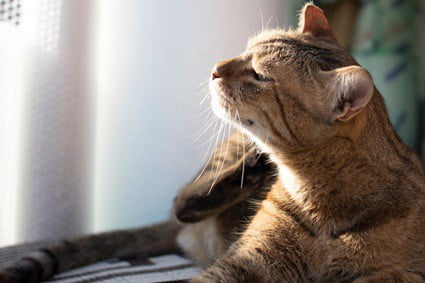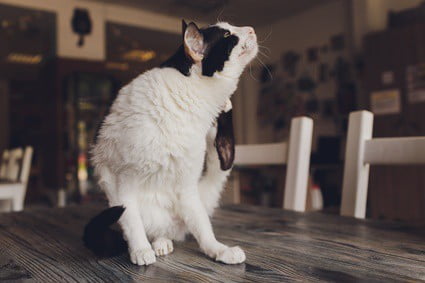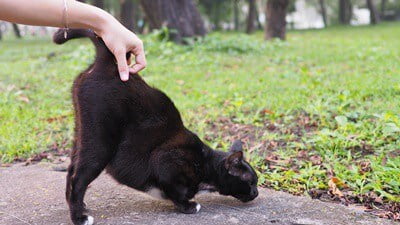Cats’ skin is thin and sensitive, which means that the skin on the lower back can easily dry out. If this area is scratched or irritated, this can lead to scaly skin, abrasions, cuts, and scabs.
Dry skin on a cat’s lower back can be due to dehydration and a lack of humidity. Improve the airflow in your home, and encourage your cat to drink more water. Ensure that your cat is getting enough protein and omega-3 fatty acid. Brush your cat’s fur regularly, especially if it’s arthritic or overweight, as it’ll struggle to groom itself.
If you find dry skin on your cat’s back, it can usually be resolved at home without medication. However, you’ll need to identify the reason for the dry skin and remove the cause. There are medical causes of dry skin in cats.
My Cat Has Dry Skin and Dandruff
Dandruff in cats is usually linked to dry skin. When a cat’s skin dries out, it’ll start to flake and fall off. Often, cats have dry skin on their back, near the tail.
Feline dandruff is most noticeable in cats with black fur. It can impact cats of any color, but the contrast of white skin flakes against dark fur makes the problem more noticeable.
As unpleasant as cat dandruff is to the eye, it rarely causes any discomfort. The dry skin may itch in some cases, causing the cat to scratch. This is not ideal as cats’ skin is paper-thin and can become sore.
If your cat is scratching a lot, ensure the dandruff is static. As explained by the Western Journal of Medicine, your cat may have cheyletiella mites. These mites cause cheyletiellosis, also known as walking dandruff.
Why Do Cats Get Dry, Flaky Skin?
To resolve feline dandruff, you need to know what causes dry skin in cats. Different solutions will present themselves, depending on the cause of the issue.
Common explanations for dry, flaky feline skin include:
- Obesity – Overweight cats struggle to reach their backs and tails while grooming.
- Arthritis – Joint problems restrict a cat’s grooming mobility.
- Allergy – An allergic reaction to food, plastic, or dust can lead to dry, inflamed skin.
- Diet – Cats rely upon protein and omega 3 fatty acid for healthy skin.
- Humidity – The hotter and drier a cat’s environment, the likelier the skin is to dry out.
- Dehydration – Cats often fail to drink enough water and grow dehydrated, drying out the skin.
- Fungal infection – Ringworm leads to dry, flaky, reddened, and itchy skin.
- Parasites – Cheyletiella mites can cause dry skin (known as cheyletiellosis or walking dandruff).
The Journal of the American Veterinary Medical Association explains that hyperadrenocorticism, a condition that impacts overweight cats, lists thin, flaky skin among the symptoms.
In most cases, dry skin, especially around the base of the tail and the back, is a lifestyle or environmental issue.
Do Cats Get Dry Skin in Winter?
If you find yourself wondering, “why is my cat’s skin so dry?” during the colder months of the year, you’ll not be alone. Indeed, cats’ skin dries out more during the winter months.
This is due to a lack of humidity in the cooler air outside, further exacerbated by artificial heat sources indoors. This lack of humidity costs feline skin around 25% of its moisture. Dry skin and dandruff will follow unless your cat actively replaces the lost moisture.
Dry skin won’t necessarily be limited to the lower back. Cold weather will cause dry weather all over a cat’s body. It may just be more pronounced at the lower back.
As mentioned, this will primarily be due to weight and muscular conditions. Cats are roughly 15% hungrier in the winter, so they will eat more. This, coupled with the instinct to sleep away during cold weather, will lead to weight gain.
In senior cats, arthritis is more likely to be a problem. Veterinary Clinics of North America: Small Animal Practice stated that arthritis is common in geriatric cats (aged 15+).
This immobility of the joints, coupled with excess weight, makes grooming the back almost impossible. Dry skin will need to be dealt with during the winter than in the summer.
How Do You Moisturize a Cat’s Skin?
Now that you have determined the reason for your cat’s dandruff, you need a solution. What helps a cat’s dry skin?
Never apply a human moisturizer to the skin of a cat. No matter how natural or expensive the product, it’ll aggravate the issue. Cats’ skin has a different PH to our own and cannot withstand products intended for humans.
Equally important is not bathing your cat constantly. You may think that getting feline skin wet will hydrate it, but bathing will actually result in additional dryness and cracking.
If your cat is struggling to care for its grooming needs, lend a hand. Limit this to brushing and, if necessary, the application of unscented wet wipes.
Home Remedies for Dry Skin on Cats
Once you know what to put on cats’ dry skin, you may be able to resolve the problem at home. You may not even need to interact with your cat physically to restore moisture to the skin on your cat’s lower back.
Olive Oil
Olive oil is nature’s moisturizer, and it can be effective against dry skin and dandruff in cats. This oil, or vegetable or almond oil, will sink into a cat’s skin, providing moisture and soothing any dry, flaky skin.
Apply two tablespoons of olive oil to a bowl and massage it into your cat’s skin and fur. Pay particular attention to the base of the back, where the dandruff is likely to be most pronounced. After 20 minutes, rinse the oil out of the fur.
Don’t use this technique more than once every 2 weeks. An olive oil skin treatment is effective enough to only require sporadic use. Olive oil is safe to consume, especially when extra virgin, so don’t be alarmed if your cat licks its fur.

Hydration
Convincing a cat to drink water can be challenging. Domesticated cats are descended from desert animals, so they feel comfortable living on the edge of dehydration. What’s more, cats can be fussy about their drinking water.
The longer a cat goes without drinking sufficient water, the drier its skin will become. By extension, this will lead to more unsightly dandruff.
Use these techniques to convince a cat to drink:
- Change the water regularly so that it remains fresh.
- Keep any water far away from food and litter, ideally in an opposite corner of a room.
- Use bottled or filtered water as the scent of chemicals in tap water deters cats from drinking.
If your cat remains unconvinced, get a water fountain. Cats prefer to drink from moving water sources.
Humidity And Airflow
Monitor the temperature of your home and cat. If a cat runs a body temperature above 102 degrees, it’s too hot. This will cause the skin to dry out and more concerning medical issues like hyperthermia.
Where possible, leave windows open to reduce the ambient temperature and keep the current of air flowing. Of course, this won’t always be a realistic option during the winter.
In such times, especially when using central heating, get a humidifier. This will keep your cat’s skin moist without creating an unwelcome draught or making your home inhospitable.
Weight Loss
Your cat may be struggling to groom its back due to weight gain.
Monitor your cat’s weight, ensuring that it doesn’t become obese. It’s only natural that older, arthritic cats will be less interested in exercise. You’ll need to encourage movement to keep the risks posed by excessive weight at bay.
You may feel that your beloved companion deserves the opportunity to live out its later years without worrying about weight. Still, it’s often unpleasant for a cat to carry excess bulk.
Cats are fussy about their cleanliness. Inability to groom, leading to dry skin and dandruff, may be causing your pet psychological distress.
Medical Treatment for Dry Skin on Cats
Unless your cat is in visible distress, scratching at dry skin, and opening wounds, you can usually persevere with home remedies. Sometimes, though, dry skin will need the intervention of a vet.
Creams and Ointments
If a cat’s skin is dry and inflamed, a vet will prescribe ointments to soothe it. These treatments are often used for easing the symptoms of allergies, so your vet will run further tests before providing a prescription.
If your cat has cheyletiellosis (walking dandruff), it’ll need treatment, such as Selamectin (Revolution), to remove the mites living on the skin. There are also oral medications, such as Selamectin (Interceptor).

Prescription Shampoos
A vet may prescribe a medicated shampoo for yeast infections, allergies, and bacterial skin infections.
Even if you have a medicated shampoo, it’s not free reign to constantly bathe your cat. You must adhere to the guidelines. Most conditions will show signs of improvement within the first few weeks.
Omega-3 Fatty Acids
Omega-3 is the collective term for a group of polyunsaturated fatty acids.
These fatty acids should feature heavily in the feline diet, especially if your cat is prone to dry skin. Omega-3’s many benefits include better skin.
Omega-3 is commonly found in most quality cat foods, especially fish-based meals. Equally, scaly fish will provide your cat with plenty of omega-3. Just ensure the fish has been completely deboned and cooked before serving.
Alternatively, you could look into omega-3 supplements. These are available over the counter in any reputable pet store in liquid or solid forms.
Specialist Diet Plan
Protein is as vital to cats’ skin as omega-3 fatty acids.
Amino acids are the building blocks that develop supple skin. If necessary, switch to a high-quality wet food diet with premium meaty chunks. A vet may even recommend a specialist prescribed cat food for dry skin.
Dry, flaky skin on a cat’s back is unsightly but can be resolved with lifestyle changes and treatments.


Hi Richard,?Thank you for your cat information on scratchy backs. The dry skin feels like many little scales. How do I know if it’s just dry and needs olive oil, or if it’s walking dandruff? Also, can that be transferred to human owners?!😳
Thank you! Julie🤓